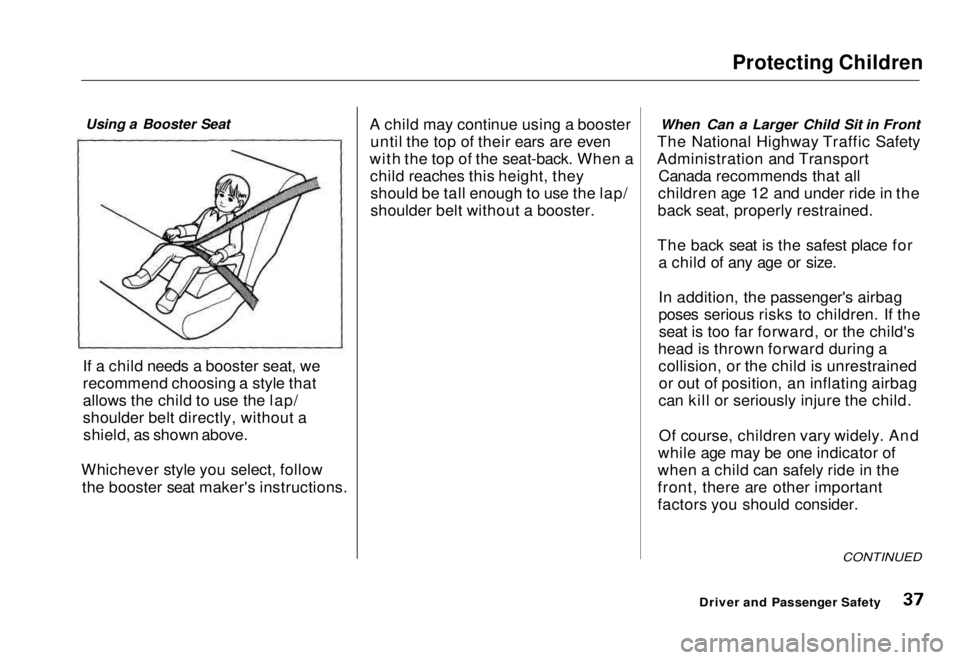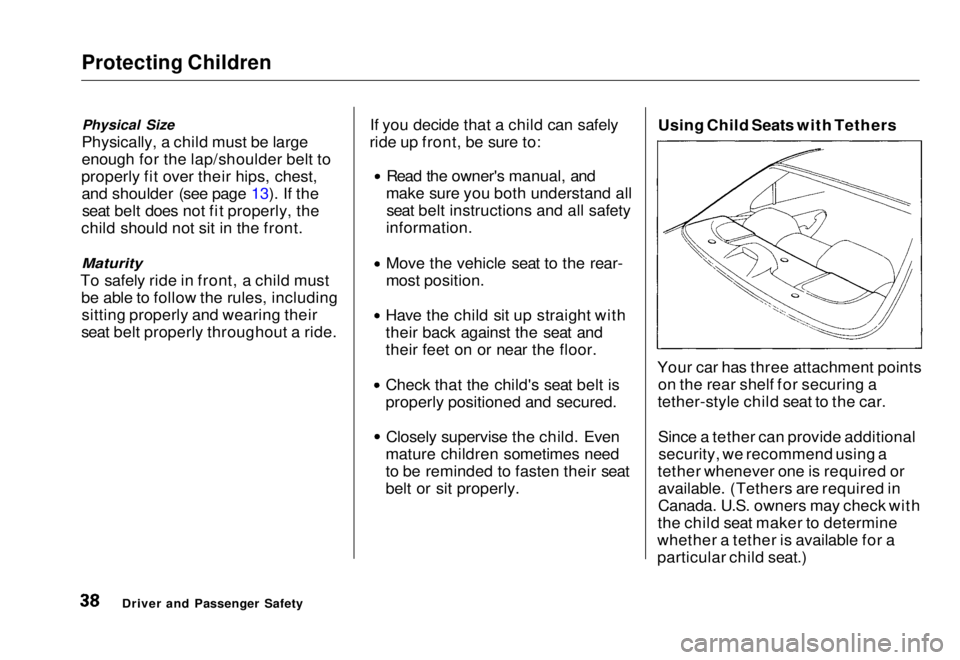Page 38 of 251

Protecting Children
If the shoulder part of the belt rests
over the child's collarbone and
against the center of the chest, as
shown above, the child is large
enough to wear the seat belt. However, if the belt touches or
crosses the child's neck, the child
needs to use a booster seat.
Do not let a child wear a seat belt
across their neck. This could result
in serious neck injuries during a
crash.
Do not let a child put the shoulder
part of a seat belt behind their back or under their arm. This could cause
very serious injuries during a crash. It also increases the chance of a
child sliding under the belt and being
injured in a crash.
Do not put any accessories on a seat
belt. Devices intended to improve
occupant comfort, or reposition the
shoulder part of a seat belt, severely
compromise the protective capability
of seat belts and increase the chance
of serious injury in a crash.
Two children should never use the
same seat belt. If they do, they could
be very seriously injured in a crash.
Driver and Passenger SafetyMain Menu Table of Contents s t
Page 39 of 251

Protecting Children
Using a Booster Seat
If a child needs a booster seat, we
recommend choosing a style that
allows the child to use the lap/
shoulder belt directly, without a shield, as shown above.
Whichever style you select, follow the booster seat maker's instructions. A child may continue using a booster
until the top of their ears are even
with the top of the seat-back. When a child reaches this height, theyshould be tall enough to use the lap/
shoulder belt without a booster.
When Can a Larger Child Sit in Front
The National Highway Traffic Safety
Administration and Transport Canada recommends that all
children age 12 and under ride in the
back seat, properly restrained.
The back seat is the safest place for a child of any age or size.
In addition, the passenger's airbag
poses serious risks to children. If theseat is too far forward, or the child's
head is thrown forward during a collision, or the child is unrestrainedor out of position, an inflating airbag
can kill or seriously injure the child.
Of course, children vary widely. And
while age may be one indicator of
when a child can safely ride in the
front, there are other important
factors you should consider.
CONTINUED
Driver and Passenger SafetyMain Menu Table of Contents s t
Page 40 of 251

Protecting Children
Physical Size
Physically, a child must be large
enough for the lap/shoulder belt to
properly fit over their hips, chest, and shoulder (see page 13). If theseat belt does not fit properly, the
child should not sit in the front.
Maturity
To safely ride in front, a child must be able to follow the rules, includingsitting properly and wearing their
seat belt properly throughout a ride. If you decide that a child can safely
ride up front, be sure to: Read the owner's manual, and
make sure you both understand all seat belt instructions and all safety
information. Move the vehicle seat to the rear-
most position.
Have the child sit up straight with
their back against the seat and
their feet on or near the floor.
Check that the child's seat belt is
properly positioned and secured.
Closely supervise the child. Even
mature children sometimes need
to be reminded to fasten their seat
belt or sit properly. Using Child Seats with Tethers
Your car has three attachment points on the rear shelf for securing a
tether-style child seat to the car.
Since a tether can provide additionalsecurity, we recommend using a
tether whenever one is required or available. (Tethers are required in
Canada. U.S. owners may check with
the child seat maker to determine
whether a tether is available for a
particular child seat.)
Driver and Passenger SafetyMain Menu Table of Contents s t
Page 41 of 251
Protecting Children
To attach a tether to your car: 1. Using the illustration on page 38, locate the attachment point you
want to use.
2. Remove the plug with a small flat- tipped screwdriver or a fingernail
file.
3. Install the anchor plate and
mounting hardware. The
hardware is available for purchase
from your Honda dealer (part number 82410-SE3-C01). ForCanadian models, the hardware is
supplied with the vehicle.
When installing tether hardware,
make sure the toothed washer is on
the bottom of the bolt. Tighten the
bolt to: 16 lbf.ft (22 N.m, 2.2 kgf.m)
If a torque wrench was not used, see
your Honda dealer as soon as possible to verify proper installation.
To attach the tether to the child seat,
follow the child seat maker'sinstructions.
If you are not sure how to install the
tether, or you need mounting hardware, contact your Honda dealer.
Driver and Passenger SafetyMain Menu Table of Contents s t
Page 42 of 251

Additional Information About Your Seat Belts
Seat Belt System Components
Your seat belt system includes lap/ shoulder belts in the front seats and
the outer back seats, and a lap belt in
the center back seat.
The system also includes alight on the instrument
panel to remind you and your passengers to fasten your belts. If
the driver's seat belt is not fastened
before the ignition is turned ON (II),
the light will come on and a beeper
will also sound. The beeper will stop after a few seconds, but the light willstay on until the driver's seat belt is
fastened.
Lap/Shoulder Belt
This seat belt has a single belt that goes over your shoulder, across yourchest and across your hips.
To fasten the belt, insert the latch plate into the buckle, then tug on the
belt to make sure the buckle is
latched.
To unlock the belt, push the red PRESS button on the buckle.Guide the belt across your body to
the door pillar. After exiting the
vehicle, be sure the belt is out of the way and will not get closed in the
door.
All lap/shoulder belts have an emergency locking retractor.
In normal driving, the retractor lets
you move freely in your seat while it keeps some tension on the belt.
During a collision or sudden stop,
the retractor automatically locks the
belt to help restrain your body.
The lap/shoulder belts in all seating positions except the driver's have anadditional locking mechanism that
can be activated to secure a child seat. (See pages 28 and 32 for
instructions on how to secure childseats with this type of seat belt.)
If the shoulder part of the belt is
pulled all the way out, the locking
mechanism will activate. The belt
will retract, but it will not allow a passenger to move freely.
Driver and Passenger SafetyMain Menu Table of Contents s t